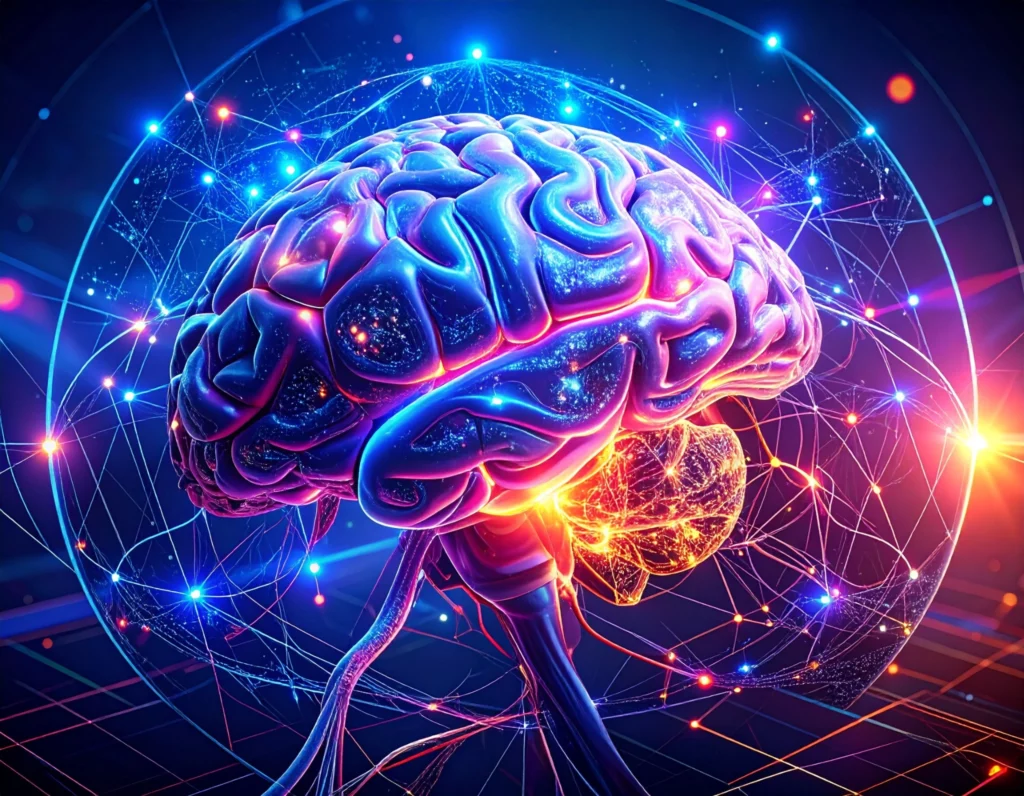 The Hidden Wiring of Thought
The Hidden Wiring of Thought
Every millisecond, trillions of electrical impulses leap through your brain and body — guiding every thought, twitch, and heartbeat. Beneath this quiet storm lies one of biology’s most elegant innovations: the myelin sheath.
This fatty, layered insulation wraps around neuron axons, turning fragile strands of cellular wiring into a lightning-fast communication network. But myelin isn’t static. It’s alive — growing, remodeling, and even learning.
Recent neuroscience, like the landmark review “Myelin Dynamics Throughout Life: An Ever-Changing Landscape?” (Fields, 2018), has revealed something astonishing: myelin adapts across your entire lifespan. It thickens with experience, thins with disuse, and even regenerates when coaxed correctly. This plasticity suggests that intelligence is not only about neurons firing — it’s about how fast and efficiently those signals travel.
And that realization has captivated a surprising audience: AI researchers.
Nature’s Bandwidth Upgrade
At its simplest, myelin acts like the rubber coating around electrical wires — preventing signal loss and short circuits. But its design is far more intricate.
Each myelin sheath is a multilamellar wrapping made of lipids and proteins, produced by specialized cells — oligodendrocytes in the brain and Schwann cells in the peripheral nervous system. Instead of forming one continuous sleeve, myelin is segmented, leaving tiny uninsulated gaps called nodes of Ranvier.
These nodes act as signal amplifiers. Electrical impulses — known as action potentials — don’t crawl along the axon; they jump from node to node in a leapfrogging process called saltatory conduction. This leap reduces energy cost while increasing transmission speed up to 100x faster than unmyelinated fibers.
If neurons are the brain’s processors, myelin is its bandwidth optimizer — dynamically tuning the flow of data through experience.
Plastic Myelin: The Brain’s Hidden Learning System
For decades, neuroscientists thought myelin formed early in life and remained mostly fixed. But modern imaging has shattered that assumption. Using high-resolution MRI and two-photon microscopy, researchers have observed that myelin continually remodels, even in adults.
In one experiment, mice trained on a new motor skill developed fresh myelin along key neural pathways — within days. When the process was disrupted, learning slowed dramatically.
This shows that myelin plasticity is not just maintenance; it’s a form of learning.
The 2018 review by Fields and colleagues proposed that myelin change represents an additional layer of neural computation — a “slow-learning” system that complements the fast synaptic network. Synapses encode what to learn. Myelin dictates how efficiently that learning can travel.
This discovery bridges biology with computer science — hinting at how future AI systems might evolve not by growing bigger brains, but by improving their signal efficiency.
Artificial Intelligence Meets Biological Bandwidth
When AI researchers build models like neural networks, they often think in terms of connections — weights, activations, layers. But in the human brain, the speed and reliability of those connections matter just as much as their topology.
Here’s where myelin inspires AI.
Imagine a neural network that can “wrap” its most-used pathways in digital insulation — dynamically allocating computational bandwidth to critical data flows, just as myelin does for repetitive or essential actions.
This concept, sometimes called dynamic conduction optimization, is emerging in research combining neuromorphic engineering and reinforcement learning.
At the frontier, scientists are experimenting with AI models that simulate myelination — adjusting signal propagation delays in virtual neurons based on “experience.” Over time, well-used connections are reinforced and sped up, while neglected ones decay — echoing biological learning.
Such architectures don’t just process data; they evolve communication efficiency, creating networks that can adapt their internal timing — a cornerstone of both intelligence and resilience.
When the Insulation Fails
Understanding myelin also sheds light on its tragic counterpart: demyelination.
Diseases like Multiple Sclerosis (MS), Guillain-Barré syndrome, and neuromyelitis optica destroy this delicate insulation, disrupting nerve signaling and leaving patients with muscle weakness, vision loss, and cognitive decline.
Unlike in peripheral nerves, where Schwann cells can regenerate damaged myelin, the brain’s oligodendrocytes are less forgiving.
Once stripped, many axons in the central nervous system never recover — a biological equivalent of a severed fiber optic line.
Yet hope lies in the same principles that make myelin dynamic.
Ongoing studies explore remyelination — coaxing oligodendrocyte precursor cells (OPCs) to form new sheaths. Experimental drugs like clemastine fumarate and metformin have shown promise in animal models and early human trials.
AI is now entering this field too — not as a metaphor, but as a diagnostic and modeling tool.
AI as a Microscope: Modeling Myelin in Silico
Machine learning systems are increasingly used to simulate biological myelination, track disease progression, and identify promising repair compounds.
For instance, deep learning algorithms trained on MRI datasets can detect subtle demyelination long before symptoms appear, outperforming traditional diagnostic criteria.
But beyond diagnostics, AI’s real power is modeling the process itself — simulating how changes in sheath thickness, axonal diameter, and conduction velocity affect neural circuit behavior.
Some projects merge biophysical equations with AI-driven optimization, creating hybrid models that mimic how myelin adapts in real brains. These digital twins can predict how repairing certain tracts could restore lost function, or how electrical timing shifts contribute to disorders like epilepsy or autism.
It’s the beginning of a new frontier — bio-inspired intelligence engineering, where we study not just how the brain thinks, but how it communicates.
A Symphony of Timing
One of myelin’s most underappreciated roles is temporal coordination.
By tuning conduction speed, it ensures that signals from different parts of the brain arrive in sync — a bit like an orchestra where some musicians must play slightly earlier so that their notes reach the listener simultaneously.
This concept — temporal alignment through adaptive conduction — offers profound insights for AI systems managing distributed computation.
In neuromorphic chips, where timing drift and latency variation can derail performance, myelin-inspired timing control could maintain coherence across billions of parallel processes.
As AI architectures grow more complex, the biological blueprint of myelin offers a crucial reminder: intelligence is not only pattern recognition; it’s synchronization.
The Lifelong Circuit
The NIH paper that anchors this discussion — Myelin Dynamics Throughout Life — reframes myelin as a lifelong partner in cognition.
From infancy through old age, it remains in flux, responding to environment, experience, and need. Even mild exercise, meditation, or cognitive challenge can stimulate myelination in key regions.
The implication is humbling: learning physically reshapes the brain’s wiring speed.
And in turn, it points to a future where digital systems might do the same — learning how to learn faster by optimizing their internal conduction networks.
The Future of Synthetic Myelin
Researchers are now imagining artificial analogs of myelin — materials that could wrap synthetic axons or fiber-optic bundles to mimic biological conduction properties.
Others explore electronic myelination in neuromorphic processors, where AI models dynamically insulate frequently used pathways to enhance efficiency and reduce energy consumption.
In the long term, this could lead to self-optimizing hardware — machines that don’t just compute, but reorganize their physical and logical connections in response to experience.
The convergence of biology and AI here is poetic.
Our machines may soon mirror not just how we think, but how we connect.
Closing Thoughts: Lessons from the Living Wire
The story of myelin is not only about neurons; it’s about communication, resilience, and adaptation.
It shows that intelligence — biological or artificial — depends as much on how well signals move as on what those signals mean.
Whether in a human brain or a neural network, the most profound kind of learning may not happen in the nodes themselves, but in the spaces between — the dynamic, adaptive pathways that carry thought from one spark to another.
Reflective Questions
- If intelligence depends on signal efficiency, could “digital myelination” become a new frontier in AI optimization?
- What might happen if future neural interfaces could enhance or restore myelin dynamics in real time?
- Could synthetic systems ever achieve the same lifelong adaptability that biological myelin demonstrates?



